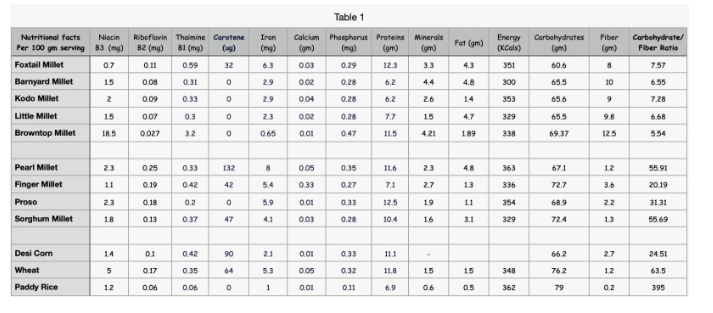Know more about millets
Millets: Nature's Nutritious Powerhouses
What are Millets?
Millets are a diverse group of small-seeded grains that have been cultivated and consumed for centuries. These gluten-free nutri-cereals are known for their exceptional nutritional value and adaptability to grow in
extreme conditions without the use of any pesticides or excessive water. Millets are a rich source of of dietary fibre and micronutrients. They significantly contribute to human diets owing to their high levels
of energy, calcium, iron, zine, lipids, and high-quality proteins.
Our millets undergo a meticulous processing method to preserve their natural goodness. We ensure that the millets are cleaned, hulled, and dehulled with precision, retaining their nutritional content. The careful
processing guarantees that you receive the finest quality millets with all their health benefits intact.
Benefits of Eating Millets:
Including millets in your diet offers a multitude of health benefits:
- Rich in Nutrients: Millets are packed with vitamins, minerals, and essential amino acids, supporting overall well-being.
- High in Fiber: The abundant fiber content aids digestion, promotes satiety, and helps maintain a healthy weight.
- Low Glycemic Index: Millets have a low glycemic index, stabilizing blood sugar levels and reducing the risk of diabetes.
- Gluten-Free: Ideal for individuals with gluten sensitivities, millets are a safe and nutritious grain alternative.
- Heart-Healthy: The presence of antioxidants and healthy fats contribute to a healthy heart.
Types of Millets Available in India:
India boasts a rich diversity of millet varieties. Some prominent types include:
1. Foxtail Millet (Korra/ Kangni/ Kakum/ Rala/ Tenai/ Navane/ Italian millet)
2. Little Millet (Samai/ Same/ Vari/ Kutki/ Samulu)
3. Barnyard Millet (Sanwa/ Udhalu/ Vrat ka chawal/ Udhalu/ Jhangora/ Japanese millet)
4. Kodo Millet (Varagu/ Kodon/ Kodro/ Arka/ Arikelu)
7. Sorghum Millet (Jowar/ Cholam/ Jola)
8. Pearl Millet (Bajra/ Sajje/ Kambu)
9. Finger Millet (Ragi/ Nachani/ Mandua)
Millets can be categorized based on their carbohydrate to fiber ratio as:
-Positive Grains: These millets have high dietary fiber ranging from 8% to 12.5% and a very low carbohydrate to fiber ratio (between 5.5% to 7-5%). Positive millets offer huge health benefits, stablilise blood sugar
levels and help us fight lifestyle diseases. The 5 positive millets are Foxtail, Little, Barnyard, Kodo and Browntop
-Neutral Grains: Neutral millets have dietary fiber between 2% to 4% and a carbohydrate to fiber ratio between 20% to 55%. They have fewer health benefits than positive millets but they do not harm the body in any
way. The neutral millets are Proso, Sorghum, Pearl and Finger Millet
-Negative Grains: Negative millet grains have a dietary fiber of less than 2% and a very high carbohydrate to fiber ratio between 63% to 395%. They are difficult to digest by the body. Examples are rice and
wheat. These grains are best avoided
At Super Millets, we are passionate about offering you the finest millets, carefully sourced and processed to retain their natural goodness. Embrace the goodness of millets and unlock the power of nutritious eating.
- Sustainable & Eco-Friendly: Millets are environmentally friendly, requiring less water and minimal pesticide use compared to other grains.
What are Millets?
Millets are a diverse group of small-seeded grains that have been cultivated and consumed for centuries. These gluten-free nutri-cereals are known for their exceptional nutritional value and adaptability to grow in
extreme conditions without the use of any pesticides or excessive water. Millets are a rich source of of dietary fibre and micronutrients. They significantly contribute to human diets owing to their high levels
of energy, calcium, iron, zine, lipids, and high-quality proteins.
Our millets undergo a meticulous processing method to preserve their natural goodness. We ensure that the millets are cleaned, hulled, and dehulled with precision, retaining their nutritional content. The careful
processing guarantees that you receive the finest quality millets with all their health benefits intact.
Benefits of Eating Millets:
Including millets in your diet offers a multitude of health benefits:
- Rich in Nutrients: Millets are packed with vitamins, minerals, and essential amino acids, supporting overall well-being.
- High in Fiber: The abundant fiber content aids digestion, promotes satiety, and helps maintain a healthy weight.
- Low Glycemic Index: Millets have a low glycemic index, stabilizing blood sugar levels and reducing the risk of diabetes.
- Gluten-Free: Ideal for individuals with gluten sensitivities, millets are a safe and nutritious grain alternative.
- Heart-Healthy: The presence of antioxidants and healthy fats contribute to a healthy heart.
Types of Millets Available in India:
India boasts a rich diversity of millet varieties. Some prominent types include:
1. Foxtail Millet (Korra/ Kangni/ Kakum/ Rala/ Tenai/ Navane/ Italian millet)
2. Little Millet (Samai/ Same/ Vari/ Kutki/ Samulu)
3. Barnyard Millet (Sanwa/ Udhalu/ Vrat ka chawal/ Udhalu/ Jhangora/ Japanese millet)
4. Kodo Millet (Varagu/ Kodon/ Kodro/ Arka/ Arikelu)
7. Sorghum Millet (Jowar/ Cholam/ Jola)
8. Pearl Millet (Bajra/ Sajje/ Kambu)
9. Finger Millet (Ragi/ Nachani/ Mandua)
Millets can be categorized based on their carbohydrate to fiber ratio as:
-Positive Grains: These millets have high dietary fiber ranging from 8% to 12.5% and a very low carbohydrate to fiber ratio (between 5.5% to 7-5%). Positive millets offer huge health benefits, stablilise blood sugar
levels and help us fight lifestyle diseases. The 5 positive millets are Foxtail, Little, Barnyard, Kodo and Browntop
-Neutral Grains: Neutral millets have dietary fiber between 2% to 4% and a carbohydrate to fiber ratio between 20% to 55%. They have fewer health benefits than positive millets but they do not harm the body in any
way. The neutral millets are Proso, Sorghum, Pearl and Finger Millet
-Negative Grains: Negative millet grains have a dietary fiber of less than 2% and a very high carbohydrate to fiber ratio between 63% to 395%. They are difficult to digest by the body. Examples are rice and
wheat. These grains are best avoided
At Super Millets, we are passionate about offering you the finest millets, carefully sourced and processed to retain their natural goodness. Embrace the goodness of millets and unlock the power of nutritious eating.
- Sustainable & Eco-Friendly: Millets are environmentally friendly, requiring less water and minimal pesticide use compared to other grains.

